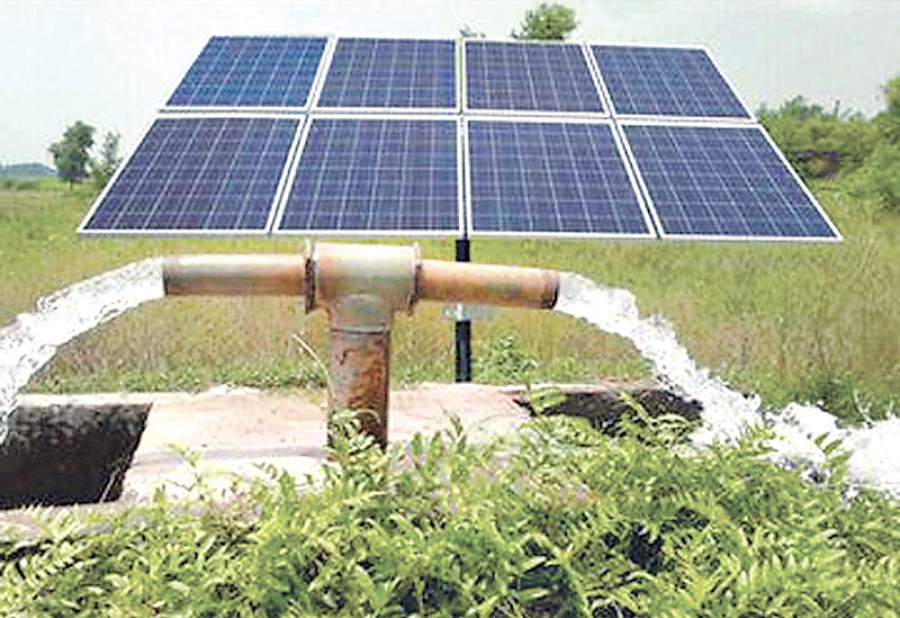Columns
Building gender-responsive policies
Policies fail to address gender inequalities if they are developed with a ‘gender-neutral’ mindset.
Labisha Uprety
An increasingly common sight in the lush fields of southern Nepal is the glinting of solar panels in sunlight. Farmers have been introduced to solar irrigation through both government and development partner efforts, and further through each other as several became early adopters of the technology. Solar irrigation pumps (SIPs), a clean and profitable alternative to diesel pumps, are particularly useful in areas that receive high radiation and have little access to electricity. Its use provides opportunities for greater yield, crop diversification and reduced cost of water pumping in the long run.
The Government of Nepal has promoted the use of solar energy and solar irrigation using several policy instruments in the water, energy, and agriculture sectors. However, earlier research at the International Water Management Institute (IWMI) shows that access to SIPs for women and small holder farmers is often limited. With the country being held up by small farmers, and farm labour increasingly feminised, programs and policies need to be inclusive and well-targeted to these populations.
For an ongoing study, IWMI looked at the degree of equity and inclusion in solar irrigation policies. Based on a study of 19 policies in water, energy, and food, and using a comprehensive methodology ranking these policies from gender-blind, gender-aware, and gender-responsive to gender-transformative, it was found that while gender transformative interests are well reflected in national development frameworks, including the Constitution of Nepal, sectoral policies show variability in the understanding and embeddedness of gender and inclusion.
Certain water-related policies show a general gender awareness, with policies aiming to increase access of women and disadvantaged groups to resources, skills, and information, and the need to consider these voices in water user groups, and related projects (e.g. the Irrigation Policy 2013 and the Irrigation Master Plan 2019). However, several others have limited considerations of gender equality and social inclusion (GESI). For instance, though the recent National Water Resources Policy 2020 envisions contributions to economic prosperity and social transformation through holistic, equitable, sustainable development and multiple uses of water resources, ‘inclusion’ and ‘gender’ are not practically addressed in strategic actions presented in the policy.
Further, energy-related policies do not address gender inequalities as if they are developed with the assumption that energy is ‘gender-neutral’ and that its access and use are not different for men and women. ‘Gender’ or ‘women’ are usually referenced for domestic issues like ‘clean cooking’ as promoted by the National Energy Strategy 2013. While the strategy highlights systemic barriers to women and minorities in energy access and decision-making, the discussion is limited to addressing women’s concerns on the use of traditional fuelwood rather than discussing productive usage of energy for women (for instance through increased access and use of irrigation) who are slowly becoming the dominant farmer in the fields.
When it comes to solar irrigation, the primary policy remains the Renewable Energy Subsidy Policy, which provides a blanket 60 percent subsidy on solar irrigation pump systems (the 2022 version recently replaced the 2016 one). Local municipal offices also often provide additional subsidies, making it affordable for successful applicants, and typically farmers pay virtually nothing to have these solar irrigation systems installed. However, our findings show that women and minorities are often unaware of these subsidies. Limited social capital, lack of formal land ownership documents, and limited use of accessible means of information by agencies mean that those who could benefit the most from these subsidies are often missed out.
Agriculture-related policies are more progressive and insistent on gender and social inclusion considerations. The Agriculture Development Strategy (ADS) 2015-35 showcased high gender responsiveness, acknowledging intricacies of poverty, exclusion, food security and gender, and has an inbuilt GESI component as part of its outputs. The ADS also has a complimentary and separate GESI strategy, led by UN WOMEN, which provides approaches for gender transformative change including, inclusion of GESI courses in agriculture training, equitable access to and control over resources and technologies by women and disadvantaged groups, and building technical capacity for women farmers and smallholder farmers.
The GESI strategy recognises women and smallholders as indispensable to Nepalese agriculture while acknowledging their marginalisation from productive resources and assets. It specifies parameters within the agency (skills, knowledge, self-esteem, aspirations), structure (laws, policies, norms, institutional practices), and relations (power dynamics within households) that could enable empowerment. As these documents were developed in explicit partnership with international agencies and development partners, their language is reflective of a greater interest in inclusion. While this has ensured that these strategies are GESI-sensitive, it may mean little in the long run if they are pushed only through international agencies and have little uptake from national partners.
Overall, water-energy-food policies are generally gender-aware, but their interest in gender, inclusion and inequalities is mostly centred on providing physical technology, or financing technology said to ‘combat poverty’. There seems to be an assumption that providing access to technology is sufficient for technology adoption; this is untrue as social, and household dynamics often determine who is able to actually use and benefit from technology. Moreover, GESI is synonymous with ‘women’ rather than addressing the power imbalance between men and women or between different social groups that have relegated women, marginalised men and subsistence farmers to a secondary position relative to those with power and resources. Only when policies can engage with this broadened understanding of GESI can there be successful changes in policy strategies and intended outcomes.




 5.15°C Kathmandu
5.15°C Kathmandu















